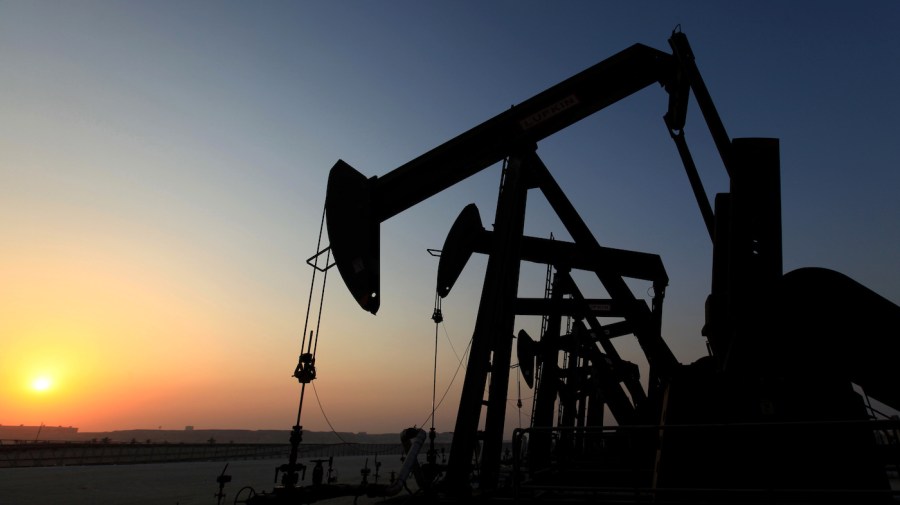Just In News | The Hill
Sustainability
Sustainability
<!–
The Big Story
Crude prices surge as Middle East tensions broil
Crude prices surged to a two-week high on Wednesday as tensions escalated in the Middle East and Iran called for an oil embargo on Israel.
© AP
Brent Crude Oil — a European benchmark used for global market purchases — rose to $91.48 by early Wednesday afternoon, or a 1.76 percent increase over the previous day, according to MarketWatch.
The West Texas Intermediate (WTI) — a futures contract traded on the New York Mercantile Exchange — sat at about $88.29, or a 1.88 percent increase from the day before.
These numbers, according to Reuters, steered Brent and WTI on course for what could be their highest closes since Sept. 29 and Oct. 3, respectively.
The upswing in oil prices marks a stark contrast from the decline we reported a week ago, when Saudi Arabia pledged to help stabilize the market amid the ongoing Israel-Hamas war.
The surge in prices came amid President Biden’s Wednesday visit to Israel, during which he expressed unwavering support for Israel while also advising its leaders to proceed with caution.
The day before, hundreds of people died in a Gaza hospital explosion. Hamas claimed an Israeli airstrike led to the blast, but Israel and the U.S. have attributed it to a misfired rocket from the Islamic Jihad group.
Iranian Foreign Minister Hossein Amir-Abdollahian has called for Islamic nations to boycott and institute an oil embargo on Israel, The New York Times reported, citing Iranian media. Iran is a longtime backer of Hamas.
While Israel imports almost all its oil — mainly from Kazakhstan, Azerbaijan and Nigeria — experts said an embargo would have little immediate effect, as the country does not rely on major Persian Gulf producers, according to the Times.
Nonetheless, such action would be reminiscent of a boycott launched by Organization of the Petroleum Exporting Countries (OPEC) in 1973 during the Arab-Israeli war and that resulted in long lines at U.S. gas pumps, the Times reported.
Yet sources from OPEC, which generates a third of global oil, told Reuters that no immediate action was being taken related to Iran’s demands.
“We are not a political organization,” one of the sources said.
Welcome to The Hill’s Sustainability newsletter, I’m Sharon Udasin — every week we follow the latest moves in the growing battle over sustainability in the U.S. and around the world.
Did someone forward you this newsletter? Subscribe here.
Essential Reads
Latest news impacting sustainability this week and beyond:
In the aftermath of Hamas’s unprecedented assault on Israel, the ensuing war is threatening to rattle a key natural gas supply hub in the Eastern Mediterranean region. Last Monday — just two days after Hamas launched the surprise attack — Israel’s Energy and Infrastructure Ministry announced a temporary halt in the supply of gas from the country’s Tamar reservoir. Located about 15 miles west of the …
The U.S. Fish and Wildlife Service (FWS) declared 21 species extinct Monday, including 10 birds and two freshwater fish. The species, which the agency removed from the list of those protected under the Endangered Species Act (ESA) due to extinction, are part of a list of 23 that were proposed for delisting two years ago.
Wildfire smoke may linger in homes long after first responders have extinguished the initial blaze, a new study has found. Components of the smoke can attach to home surfaces, such as carpets, drapes or counters — prolonging exposure to those inside and possibly causing health issues, according to the study, which was published Friday in Science Advances. Although this risk can remain even after initial air purification, the …
(KTVX) — If you can get a scientist to say “wow,” then you’re in pretty impressive territory. According to NASA’s OSIRIS-REx asteroid researchers, they’ve been saying “wow” quite a bit since their asteroid sample landed on Earth.
Lights Out?
Climate change intensifying urban electricity use
© Getty
As climate-driven warming leaves American cities sweating, urban buildings may sustain much more frequent surges in peak electricity usage over the coming decades, a new study has found.
The energy required to cool U.S. buildings could increase by 13.8 percent for each degree of warming on average, according to the study, published on Wednesday in Nature Communications.
Giant urban footprints: Residential and commercial buildings in U.S. cities today consume about 39 percent of the country’s energy, the study authors noted.
They are also responsible for about 28 percent of the nation’s greenhouse gas emissions, per the U.S. Energy Information Administration.
Today, fossil fuels account for about 40 percent of all building energy consumed in U.S. urban city centers.
Figuring out the future: Given the dynamic effects of climate change, however, the researchers understood that these figures would not necessarily apply to the buildings of decades to come.
“Understanding their future energy use is very important for developing climate change mitigation strategies,” lead author Chenghao Wang, an assistant professor at the University of Oklahoma, said in a statement.
Boosting resilience at city-scale: A clearer estimate of future needs would also help people improve efficiency, develop and implement energy and environmental regulations, according to Wang, who heads the Sustainable Urban Futures Lab.
Such action, he explained, could enhance human resilience and adaptation capabilities amid extreme weather conditions.
“As global cities commit to ambitious sustainability goals, a more granular understanding of energy use at the city scale becomes imperative,” Wang added.
The intersection of warming and power use: To gain such an understanding, Wang and colleagues from around the world focused on 277 cities across the contiguous U.S.
They used model simulations and future climate projections to consider four possible warming scenarios and two power sector scenarios.
One power scenario assumed not future carbon policies would be implemented.
The second involved rapid decarbonization and net-zero emissions transitions by 2050, in line with climate goals announced by President Biden earlier this year.
Calculating consumption: Wang and his colleagues then used an indicator called energy use intensity (EUI), or the energy consumed per square foot per year, to determine how urban building energy use could evolve.
They calculated the EUI by dividing the total energy used in the buildings by their total gross floor area, the authors explained.
What did they find? The researchers observed that city-scale building EUI would undergo uneven changes by the 2050s, in comparison to baseline levels in the 2010s.
The biggest increases would affect the South, Southwest, West and Southeast portions of the U.S., which would see a surge of up to 7.2 percent, according to the study.
Peak usage could persist: The scientists also identified a likely rise in the frequency of summer peak electricity usage in urban buildings.
They found an average of 10.1 percent to 37.7 percent surge in such settings across the country.
Some cities, however, may incur greater than 110-percent increases.
“This will require higher grid capacity and also greater resilience against power outages during extreme heat waves,” Wang said.
On Our Radar
Upcoming news themes and events we’re watching:
As households nationwide dust off Halloween decorations and holiday lights, Colorado Parks and Wildlife has asked residents of the Centennial State to evaluate their outdoor spaces for potential tangle hazards. Antlered wildlife migrating from summer habitats to winter ranges risk becoming dangerously ensnared in decorations, hammocks, garden items and sports netting, according to Parks and Wildlife.
In Other News
Branch out with different reads from The Hill:
The Environmental Protection Agency (EPA) declared Tuesday that lead in fuel for small airplanes is a danger to public health, marking a key step toward taking regulatory action.
Around The Nation
Local and state headlines on sustainability issues:
College campuses launch new ‘climate studies’ majors (Yale Climate Connections)
Climate change responsible for delayed Cape Cod cranberry harvests, says researcher (Cape and Islands/NPR)
What We’re Reading
Sustainability news we’ve flagged from other outlets:
UK police charge climate activist Greta Thunberg after protest (Reuters)
Billionaire Mike Bloomberg’s Philanthropies arm just announced $50 million to help cities with climate change, other global issues (Fortune)
What Others are Reading
More stories on The Hill right now:
A report released in June projected more than 70,000 child care programs could shut down without additional funding. Read more
Lake Mead officials are warning hikers planning to head to popular hot springs below Hoover Dam: Avoid any activity that involves splashing or submerging your head. Read more
What People Think
Opinions related to sustainability submitted to The Hill:
Biden’s kamikaze climate plan for the US economy
You’re all caught up. See you next week!
Sustainability, Newsletters, Brent Crude Oil, Gaza, Hamas, Iran, Iranian Foreign Minister Hossein Amir-Abdollahian, islam, Islamic Jihad group, Israel, oil prices, President Biden, west texas intermediate Read More
Author Profile
Latest entries
 HeadlinesOctober 24, 2024State senator dies following freak lawn mower accident
HeadlinesOctober 24, 2024State senator dies following freak lawn mower accident HeadlinesOctober 24, 2024Letter at center of Menendez brothers' bid for freedom called into question
HeadlinesOctober 24, 2024Letter at center of Menendez brothers' bid for freedom called into question HeadlinesOctober 24, 2024Ask a doctor: ‘Why are my ears ringing, and should I see a physician?’
HeadlinesOctober 24, 2024Ask a doctor: ‘Why are my ears ringing, and should I see a physician?’ HeadlinesOctober 24, 2024Trump camp says Dem rhetoric 'directly to blame' for past assassination attempts
HeadlinesOctober 24, 2024Trump camp says Dem rhetoric 'directly to blame' for past assassination attempts

